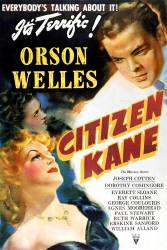Trivia: Steven Spielberg bought the famous 'Rosebud' prop at an auction in 1982 for $60,500. When Orson Welles heard about this, it was reported that his reaction was, 'I thought we burned it.'
Trivia: The shot of the loud, squawking bird was purposely placed by Orson Welles to make sure the audience was still awake.
Trivia: When the film was released, the Hearst newspapers refused to mention it by name, only calling it an "exciting RKO release." Before its release, publisher William Randolph Hearst, the owner of the newspapers, unsuccessfully attempted to block the film because he felt that the character of Charles Foster Kane is based on his life.
Trivia: Charles Foster Kane was based on publishing legend William Randolph Hearst and the movie has many in-jokes and gags given at Hearst's expense. The one that Hearst probably took the most offense to was the use of "Rosebud" in the film - it wasn't a childhood toy of his, but the pet name he had given his mistress' private parts.
Trivia: This was the first motion picture to introduce "ceilings" into a shot of a scene taking place indoors from an actual set. Before this, due to the extreme lighting needed, the set was shot at angle that did not reveal that there was no ceiling on the set itself, otherwise it would have had to been shot indoors at a real location, which made for poor lighting that looked unrealistic. Orson Welles used a technique were a piece of thin cloth material was stretched over the top of the set which allowed the stage lighting to shine through, but appeared as a solid ceiling on film, further adding to the many other techniques used in this film to give the viewer a sense of realism.
Trivia: In the famous death scene, after the snow globe crashes, the snow does not remain in the globe (or on the floor,) but instead, takes over the entire screen. It was a mistake that was noticed by director Orson Welles, but kept for its dramatic effect; he felt that it added a sense of transcendence to Kane's death that was otherwise only implied.
Trivia: To get most of his extremely low angle shots, Welles often had to dig a hole in the set to place the camera and its operator in, given the size of motion picture cameras at that time. The best example of this extreme low angle camera takes place after the political rally is finished.
Trivia: Welles worked 16 to 18 hour days on the film, as it took nearly four hours to apply his makeup to make him look older. Welles also shot the film quickly, with very few takes as he wanted to be like John Ford. Some of the film's more significant scenes were shot before production actually began as Welles had claimed he was doing "camera tests" and RKO believed him.
Trivia: Welles learned how to make films by watching what other directors were doing at the time, especially John Ford. In particular, he would watch Ford's "Stagecoach" nightly and ask his cinematographer how certain shots were done. Welles makes a nod to Ford by using a couple of Ford's most infamous shots. This includes a moving camera going through an opening door as the character walks through.
Trivia: Orson Welles was just 25 years old when he made this film.





